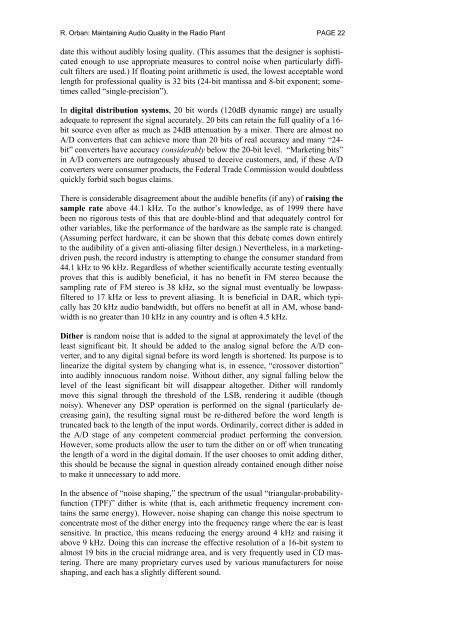Maintaining Audio Quality in the FM Plant - Orban
Maintaining Audio Quality in the FM Plant - Orban
Maintaining Audio Quality in the FM Plant - Orban
Create successful ePaper yourself
Turn your PDF publications into a flip-book with our unique Google optimized e-Paper software.
R. <strong>Orban</strong>: <strong>Ma<strong>in</strong>ta<strong>in</strong><strong>in</strong>g</strong> <strong>Audio</strong> <strong>Quality</strong> <strong>in</strong> <strong>the</strong> Radio <strong>Plant</strong> PAGE 22<br />
date this without audibly los<strong>in</strong>g quality. (This assumes that <strong>the</strong> designer is sophisticated<br />
enough to use appropriate measures to control noise when particularly difficult<br />
filters are used.) If float<strong>in</strong>g po<strong>in</strong>t arithmetic is used, <strong>the</strong> lowest acceptable word<br />
length for professional quality is 32 bits (24-bit mantissa and 8-bit exponent; sometimes<br />
called “s<strong>in</strong>gle-precision”).<br />
In digital distribution systems, 20 bit words (120dB dynamic range) are usually<br />
adequate to represent <strong>the</strong> signal accurately. 20 bits can reta<strong>in</strong> <strong>the</strong> full quality of a 16-<br />
bit source even after as much as 24dB attenuation by a mixer. There are almost no<br />
A/D converters that can achieve more than 20 bits of real accuracy and many “24-<br />
bit” converters have accuracy considerably below <strong>the</strong> 20-bit level. “Market<strong>in</strong>g bits”<br />
<strong>in</strong> A/D converters are outrageously abused to deceive customers, and, if <strong>the</strong>se A/D<br />
converters were consumer products, <strong>the</strong> Federal Trade Commission would doubtless<br />
quickly forbid such bogus claims.<br />
There is considerable disagreement about <strong>the</strong> audible benefits (if any) of rais<strong>in</strong>g <strong>the</strong><br />
sample rate above 44.1 kHz. To <strong>the</strong> author’s knowledge, as of 1999 <strong>the</strong>re have<br />
been no rigorous tests of this that are double-bl<strong>in</strong>d and that adequately control for<br />
o<strong>the</strong>r variables, like <strong>the</strong> performance of <strong>the</strong> hardware as <strong>the</strong> sample rate is changed.<br />
(Assum<strong>in</strong>g perfect hardware, it can be shown that this debate comes down entirely<br />
to <strong>the</strong> audibility of a given anti-alias<strong>in</strong>g filter design.) Never<strong>the</strong>less, <strong>in</strong> a market<strong>in</strong>gdriven<br />
push, <strong>the</strong> record <strong>in</strong>dustry is attempt<strong>in</strong>g to change <strong>the</strong> consumer standard from<br />
44.1 kHz to 96 kHz. Regardless of whe<strong>the</strong>r scientifically accurate test<strong>in</strong>g eventually<br />
proves that this is audibly beneficial, it has no benefit <strong>in</strong> <strong>FM</strong> stereo because <strong>the</strong><br />
sampl<strong>in</strong>g rate of <strong>FM</strong> stereo is 38 kHz, so <strong>the</strong> signal must eventually be lowpassfiltered<br />
to 17 kHz or less to prevent alias<strong>in</strong>g. It is beneficial <strong>in</strong> DAR, which typically<br />
has 20 kHz audio bandwidth, but offers no benefit at all <strong>in</strong> AM, whose bandwidth<br />
is no greater than 10 kHz <strong>in</strong> any country and is often 4.5 kHz.<br />
Di<strong>the</strong>r is random noise that is added to <strong>the</strong> signal at approximately <strong>the</strong> level of <strong>the</strong><br />
least significant bit. It should be added to <strong>the</strong> analog signal before <strong>the</strong> A/D converter,<br />
and to any digital signal before its word length is shortened. Its purpose is to<br />
l<strong>in</strong>earize <strong>the</strong> digital system by chang<strong>in</strong>g what is, <strong>in</strong> essence, “crossover distortion”<br />
<strong>in</strong>to audibly <strong>in</strong>nocuous random noise. Without di<strong>the</strong>r, any signal fall<strong>in</strong>g below <strong>the</strong><br />
level of <strong>the</strong> least significant bit will disappear altoge<strong>the</strong>r. Di<strong>the</strong>r will randomly<br />
move this signal through <strong>the</strong> threshold of <strong>the</strong> LSB, render<strong>in</strong>g it audible (though<br />
noisy). Whenever any DSP operation is performed on <strong>the</strong> signal (particularly decreas<strong>in</strong>g<br />
ga<strong>in</strong>), <strong>the</strong> result<strong>in</strong>g signal must be re-di<strong>the</strong>red before <strong>the</strong> word length is<br />
truncated back to <strong>the</strong> length of <strong>the</strong> <strong>in</strong>put words. Ord<strong>in</strong>arily, correct di<strong>the</strong>r is added <strong>in</strong><br />
<strong>the</strong> A/D stage of any competent commercial product perform<strong>in</strong>g <strong>the</strong> conversion.<br />
However, some products allow <strong>the</strong> user to turn <strong>the</strong> di<strong>the</strong>r on or off when truncat<strong>in</strong>g<br />
<strong>the</strong> length of a word <strong>in</strong> <strong>the</strong> digital doma<strong>in</strong>. If <strong>the</strong> user chooses to omit add<strong>in</strong>g di<strong>the</strong>r,<br />
this should be because <strong>the</strong> signal <strong>in</strong> question already conta<strong>in</strong>ed enough di<strong>the</strong>r noise<br />
to make it unnecessary to add more.<br />
In <strong>the</strong> absence of “noise shap<strong>in</strong>g,” <strong>the</strong> spectrum of <strong>the</strong> usual “triangular-probabilityfunction<br />
(TPF)” di<strong>the</strong>r is white (that is, each arithmetic frequency <strong>in</strong>crement conta<strong>in</strong>s<br />
<strong>the</strong> same energy). However, noise shap<strong>in</strong>g can change this noise spectrum to<br />
concentrate most of <strong>the</strong> di<strong>the</strong>r energy <strong>in</strong>to <strong>the</strong> frequency range where <strong>the</strong> ear is least<br />
sensitive. In practice, this means reduc<strong>in</strong>g <strong>the</strong> energy around 4 kHz and rais<strong>in</strong>g it<br />
above 9 kHz. Do<strong>in</strong>g this can <strong>in</strong>crease <strong>the</strong> effective resolution of a 16-bit system to<br />
almost 19 bits <strong>in</strong> <strong>the</strong> crucial midrange area, and is very frequently used <strong>in</strong> CD master<strong>in</strong>g.<br />
There are many proprietary curves used by various manufacturers for noise<br />
shap<strong>in</strong>g, and each has a slightly different sound.



![[PDF] Using the ITU BS.1770-2 and CBS Loudness Meters ... - Orban](https://img.yumpu.com/50629372/1/190x245/pdf-using-the-itu-bs1770-2-and-cbs-loudness-meters-orban.jpg?quality=85)






![[PDF] Optimod-FM Feature Comparison - Orban](https://img.yumpu.com/41741615/1/190x245/pdf-optimod-fm-feature-comparison-orban.jpg?quality=85)






